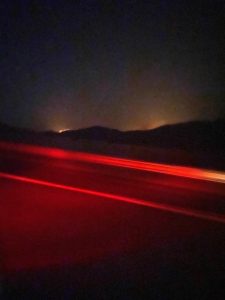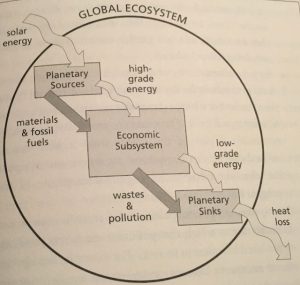The Fire This Time
At 5:44 AM on a Monday morning, my son texted me from Redding, California: “Hey pops. Pray for us, please.”
Another fire had started just over the ridge from where he and his family live, and he had just snapped the above picture from the road as he tried to head to work. As about a million acres of land burned in a little more than a month in our state, my son could see the embodiment of climate change just over that ridge, and there is nothing any professional climate change denier could say to change that. Indeed, there is nothing that any of us can honestly say to further procrastinate the changes we need to make on the only planet we know we can live on.
The Limits to Growth
In 1972, Donella Meadows, Dennis Meadows, Jorgen Randers, and William W. Behrens published The Limits to Growth (New York: Universe Books, 1972). In 2004, Donella Meadows, Jorgen Randers, and Dennis Meadows published a major follow-up to this original work: Limits to Growth: The 30 Year Update . As the authors of The Limits to Growth (LtG) recount, LtG began as a project that “took place in the Systems Dynamics Group of the Sloan School of Management within Massachusetts Institute of Technology (MIT) from 1970 to 1972.” The project team used “system dynamics theory and computer modeling to analyze the consequences of growth in the world’s population and material economy.” Mr. Meadows “assembled and directed” a project team of sixteen researchers, and the team spent two years conducting the original study.
The early work of the LtG authors and their colleagues centered around applying systems dynamics theory to develop a model of what was happening on our planet — specifically what humans were doing on it — and how this impacted the overall planet. Figure 1, below, provides a high-level view of the model that the LtG authors utilized.
If you think for a moment about even the use of the word growth, you’ve already begun to the see problem we are all facing. As the authors of LtG point out, even the “synonyms for that word: development, progress, advance, gain, improvement, prosperity, success,” are part of the daily mantra in most modern cultures; and, of course, just about all things related to business health and success — or the likelihood of it — are tied to the word growth: Revenue Growth, Growth in Market Share, Earnings Growth, etc.
Put simply: the concept of growth always being a good thing is heavily embedded in our modern societies.
The problem is the planet we live on is finite, and although there are regenerative processes on our planet, unlimited growth, and increases in growth rates, cannot go on forever.
Understanding the Exponential
As we’ve struggled through this current pandemic we are (mostly) living through a phenomenon that many people have struggled to understand: the rate at which the disease has spread has been startling. The spread has been exponential, and this has been a surprising experience. It is far easier to understand a linear rate of change, and this seems to be the way most people think about growth; but when each new element of growth is capable of producing its own new elements, we don’t have linear growth any more, we have exponential growth.
This kind of growth is far easier to understand intellectually than it is to experience in our lives, where the results are often surprising. The LtG authors give an example of how this kind of growth can surprise us from a “French Riddle”:
Suppose you own a pond. One day you notice that a single water lily is growing on your pond. You know that the lily plant will double in size each day. You realize that if the plant were allowed to grow unchecked, it would completely cover the pond in 30 days, choking off the other forms of life in the water.
But initially the lily seems small, so you decide not to worry. You’ll deal with it when it covers half the pond. How much time have you given yourself to prevent the destruction of your pond? You have left yourself one day! On the 29th day the pond is half covered. The next day — after one final doubling — the pond will be totally shaded. On the 21st day, the plant covers just 0.2% of the pond. On the 25th (day), the plant covers just 3%….
This exponential puzzle is a significant part of the challenges that we face today on our planet. As the LtG authors put it:
You can see how exponential growth, combined with response delays can lead to overshoot. For a long time the growth looks insignificant. There appears to be no problem. Then suddenly change comes on faster and faster, until, with the last doubling or two (brought on by the growth), there is no time to react.
World3: More “Growth” + Same Systems = More Hardship
The LtG authors' comprehensive discussion of the resource and consumption limits we all face and the related choices we make — whether our personal choices or the choices we increasingly face within the industrial organizations that we run — is driven by a computer model that the LtG authors developed to incorporate many of these choices. The different choices were incorporated into model simulation runs.
I have had the benefit of studying and running a few simulation runs of the World3 model myself, since it is incorporated in the Modelica system modeling and simulation language that runs in Wolfram’s SystemModeler (See an example of the LtG authors “Scenario 1” in Figure 2, below).
One of the interesting things that this model can teach us is — as the LtG authors succinctly articulate — is that although “growth is necessary to end poverty,” “…growth in the economic system, as it is currently structured, will not end poverty.” In fact, “current modes of growth perpetuate poverty and increase the gap between the rich and the poor.” This is because, if you look at the current economic system globally, economic growth generally “…flows disproportionately to the richest people….” The LtG authors refer to their observation of this phenomenon as a “‘success to the successful’ feedback loop.”
As the LtG authors point out, “running the same system harder or faster will not change the pattern as long as the structure is not revised,” (when we speak of “the system” in this context, we are merely talking about the generalized way that all modern cultures and economies are collectively behaving); so, for example, it is easier for relatively richer countries and populations to save, invest, and expand their capital base, and the opposite is true for poorer populations and countries. This also, of course, encourages exploitive, damaging choices for richer populations, and extremely limited, damaging choices for poorer populations. As the LtG authors point out, a world without “counterbalancing structures” does not help us live within our overall limits.
The Fire Over the Ridge: Overshoot And Collapse
The LtG authors define overshoot as “a population and economy…withdrawing resources or emitting pollutants at an unsustainable rate, but…not yet in a situation where the stresses on the support system are strong enough to reduce the withdrawal or emission.”
This is where we are headed very clearly: toward the fire over the ridge. Indeed, we are already living in this fire (quite literally) today. Humanity has already overshot our limits within the limited planetary system that we live in. You can run World3 through multiple of the authors “Scenarios,” you can even devise your own models and scenarios, or you can just spend a little time looking at all the data that we have at our disposal: the way that we are living is not sustainable, and, indeed, we will need to change many of our habits from the way we live day to day to the way that our businesses operate. The physical world we live is in the process of reacting to the current path we are on, and there will now, inevitably, be some form of collapse in the near future.
Is a Sustainable Revolution Possible?
Even with all the issues we are facing as a planet, as the LtG authors point out, “it is as impossible now for anyone to describe the world that could evolve from a sustainability revolution as it would have been for the farmers of 6000 BC to foresee the corn and soybean fields of modern Iowa, or an English coal miner of AD 1800 to imagine an automated Toyota assembly plant.” These other major human revolutions (agricultural and industrial) changed the “face of the land and foundations of human identities, institutions, and cultures,” and a sustainable revolution would certainly do the same.
As difficult as it is to envision a future that will, frankly, not look like anything like what we see today, we need to begin this revolution now, and the longer we delay, the more painful it will be for our children and their children.
Get new GlobeBlog Posts delivered directly to your email box. Sign-up for the BlueNotes Newsletter.



